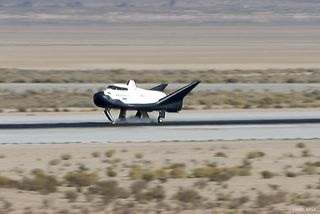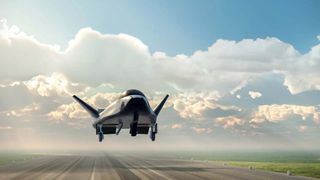Dream Chaser space plane may land at New Mexico's Spaceport America
But it's not a done deal yet.

Another landing locale may have just opened up for the private Dream Chaser space plane.
Spaceship maker Sierra Space signed a memorandum of understanding (MOU) on Tuesday (June 21) with Spaceport America, potentially paving the way for Dream Chaser to touch down at the New Mexico facility after its orbital missions.
While not a done deal, the MOU aligns the two entities in their "mutual pursuit" of a reentry license from the U.S. Federal Aviation Administration (FAA) for Dream Chaser landings in New Mexico. The FAA has already approved the spacecraft to land at Huntsville International Airport in Alabama, Sierra Space representatives noted in a press release.
Spaceport America's potential inclusion among approved landing sites will "continue to open up affordable access to space for all," Tom Vice, Sierra Space CEO, said in the release. No timeline was offered for Spaceport America landings, if approved.
In pictures: Sierra Nevada's Dream Chaser aces glide test flight

NASA has tasked Sierra Nevada with at least six uncrewed International Space Station (ISS) cargo missions using Dream Chaser. The flights will lift off from Florida's Cape Canaveral Space Force Station on United Launch Alliance Vulcan Centaur rockets.
In addition to the Alabama site, Dream Chaser is also in line to touch down at NASA's former space shuttle runway at the Launch and Landing Facility, at the agency's Kennedy Space Center in Florida.
Get the Space.com Newsletter
Breaking space news, the latest updates on rocket launches, skywatching events and more!
Other potentially compatible runways are in the works at Oita Airport in Japan and Spaceport Cornwall in the United Kingdom, Sierra Space said in its recent release.
The company at first was thinking of Dream Chaser as a crewed vehicle for ISS astronaut flights, but NASA eventually selected SpaceX and Boeing to carry crews to and from the ISS. Sierra Space may eventually build a crewed version of the space plane for other clients, however.
NASA currently receives cargo shipments at the ISS from SpaceX and Northrop Grumman. SpaceX's Dragon capsule returns experiments to Earth during re-entries, while Northrop Grumman's Cygnus is designed to burn up naturally in the atmosphere. Dream Chaser will offer another way to get cargo down to Earth from the ISS.
Follow Elizabeth Howell on Twitter @howellspace. Follow us on Twitter @Spacedotcom and on Facebook.
Join our Space Forums to keep talking space on the latest missions, night sky and more! And if you have a news tip, correction or comment, let us know at: community@space.com.

Elizabeth Howell (she/her), Ph.D., is a staff writer in the spaceflight channel since 2022 covering diversity, education and gaming as well. She was contributing writer for Space.com for 10 years before joining full-time. Elizabeth's reporting includes multiple exclusives with the White House and Office of the Vice-President of the United States, an exclusive conversation with aspiring space tourist (and NSYNC bassist) Lance Bass, speaking several times with the International Space Station, witnessing five human spaceflight launches on two continents, flying parabolic, working inside a spacesuit, and participating in a simulated Mars mission. Her latest book, "Why Am I Taller?", is co-written with astronaut Dave Williams. Elizabeth holds a Ph.D. and M.Sc. in Space Studies from the University of North Dakota, a Bachelor of Journalism from Canada's Carleton University and a Bachelor of History from Canada's Athabasca University. Elizabeth is also a post-secondary instructor in communications and science at several institutions since 2015; her experience includes developing and teaching an astronomy course at Canada's Algonquin College (with Indigenous content as well) to more than 1,000 students since 2020. Elizabeth first got interested in space after watching the movie Apollo 13 in 1996, and still wants to be an astronaut someday. Mastodon: https://qoto.org/@howellspace
